10 Proven Methods: How to Improve Swimming Endurance in 2025
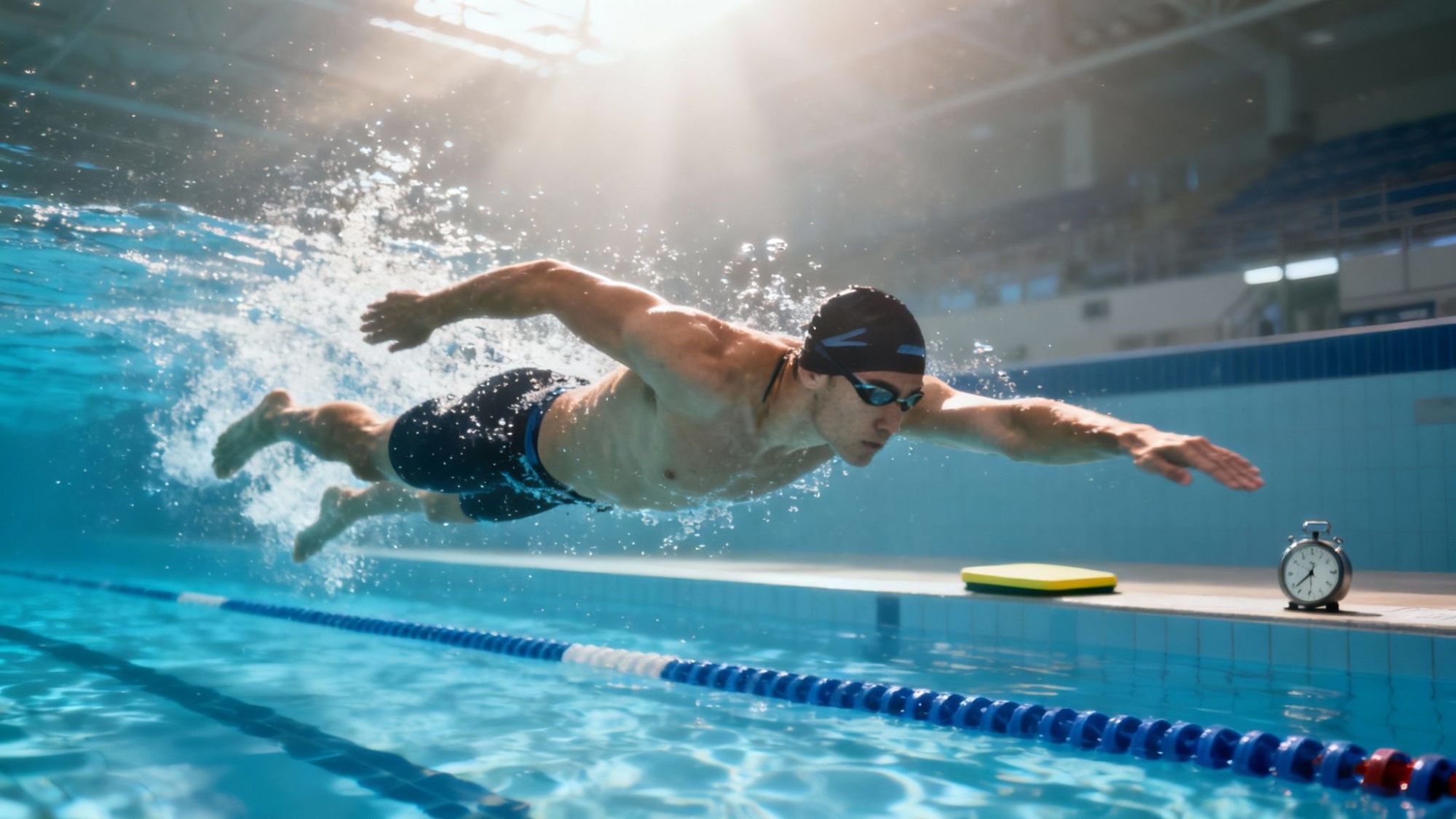
Are you ready to transform your swimming, turning short bursts of effort into powerful, sustained performance? Whether you're training for a triathlon, looking to conquer longer distances in the pool, or simply want to enjoy the water without feeling winded, the key lies in building a solid endurance base. Improving your swimming stamina isn't just about logging endless laps; it's about training smarter, not just harder. For a holistic approach to building your staying power, you can also explore general guidance on how to improve stamina for lasting energy.
This guide will explore 10 proven methods, tools, and training philosophies that elite swimmers and dedicated enthusiasts use to build incredible staying power. We'll dive into specific workout structures, cutting-edge apps, and foundational principles that will show you exactly how to improve swimming endurance and glide through the water with newfound strength. Speaking of enjoying the water, for an incredible real-world application of your new endurance, consider exploring Hawaii's vibrant marine life with Kona Snorkel Trips, the top rated & most reviewed snorkel company in Hawaii.
By the end of this article, you'll have a complete toolkit to structure your training, measure your progress, and finally break through those frustrating performance plateaus. Let's get started on your journey to becoming a stronger, more resilient swimmer.
1. Pyramid Training Workouts
Pyramid training workouts use structured intervals that rise and fall in distance or intensity within a single session. Swimmers start with shorter, high‐intensity repeats, build up to longer, moderate‐effort sets, then taper back down. This systematic approach challenges both aerobic and anaerobic systems while reinforcing consistent pacing and mental toughness. It’s a go-to method in USA Swimming protocols and was popularized by Olympian coach Bob Bowman.
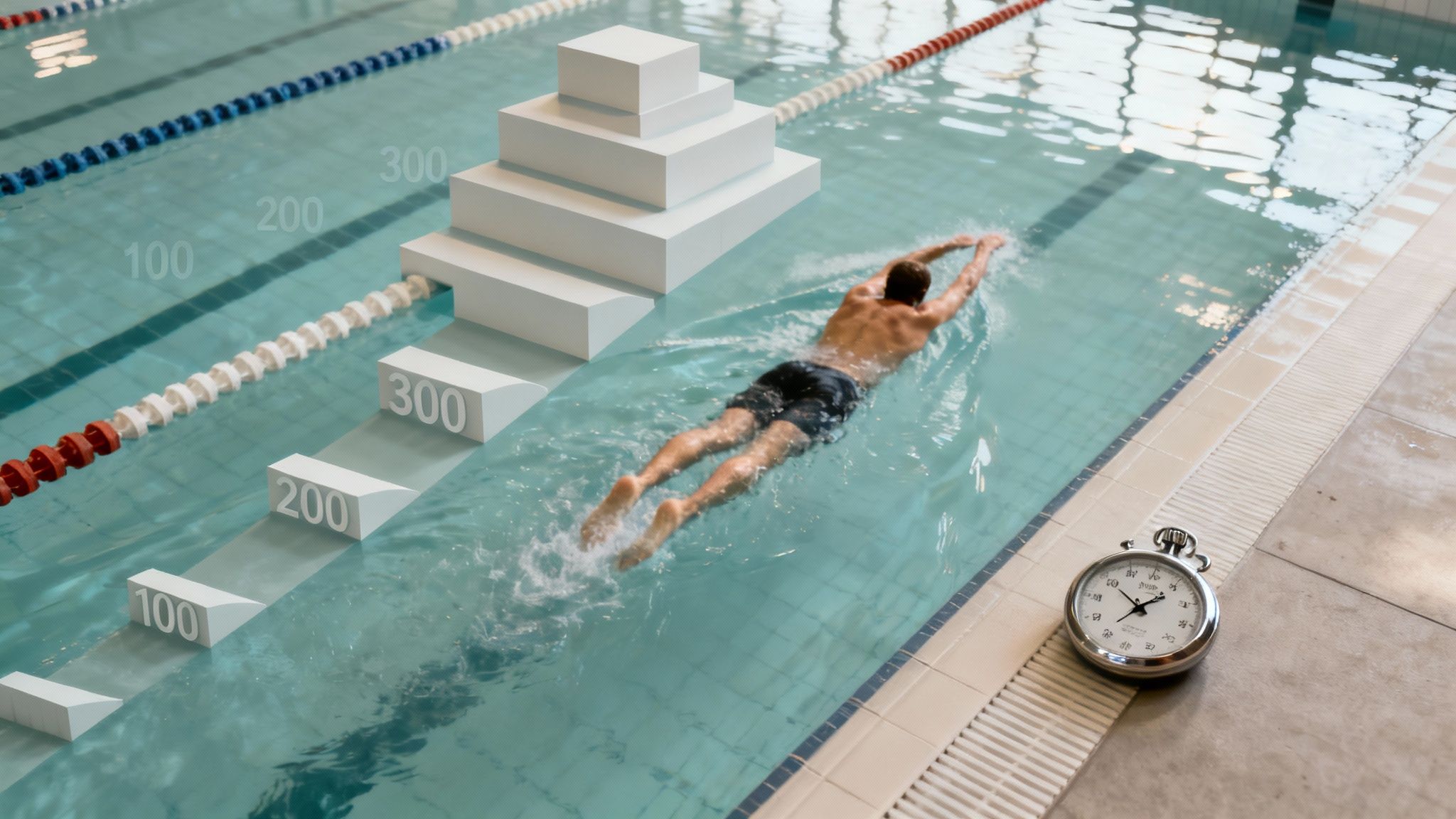
How Pyramid Sets Build Endurance
- Short repeats at high effort teach sprint recovery
- Gradual increase in distance boosts aerobic capacity
- Down‐slope back to sprints reinforces pacing control
“Pyramid sets sharpen pace awareness while expanding endurance reserves.”
Examples in Practice
- College swim teams: 4 x (100-200-300-200-100) with 20-second rest decrements
- Olympic mid-distance phases: ramp from 50m to 400m then back
- Masters clinics: mix kick, pull, and full-stroke pyramids
Actionable Tips
- Use a pace clock or wearable swim computer for split consistency
- Start simple: 100-200-300-200-100, then add longer peak (e.g., 400m)
- Decrease rest by 5–10 seconds as distances climb
When and Why to Use
- Ideal in mid-cycle training to break monotony
- Builds mental toughness before time trials
- Combines well with easy recovery days
For implementation guidance visit USA Swimming’s interval training resources: https://www.usaswimming.org/swimsuite/education/intervals.
2. SwimSmooth Coaching App
The SwimSmooth Coaching App is a comprehensive digital platform offering personalized training plans, advanced video analysis, and real-time feedback. Developed by elite coaches, it uses AI to analyze stroke technique from smartphone videos, providing customized endurance-building workouts tailored to your goals and fitness level. It’s an accessible way to get expert coaching, a strategy popularized by SwimSmooth founders Paul Newsome and Adam Young.
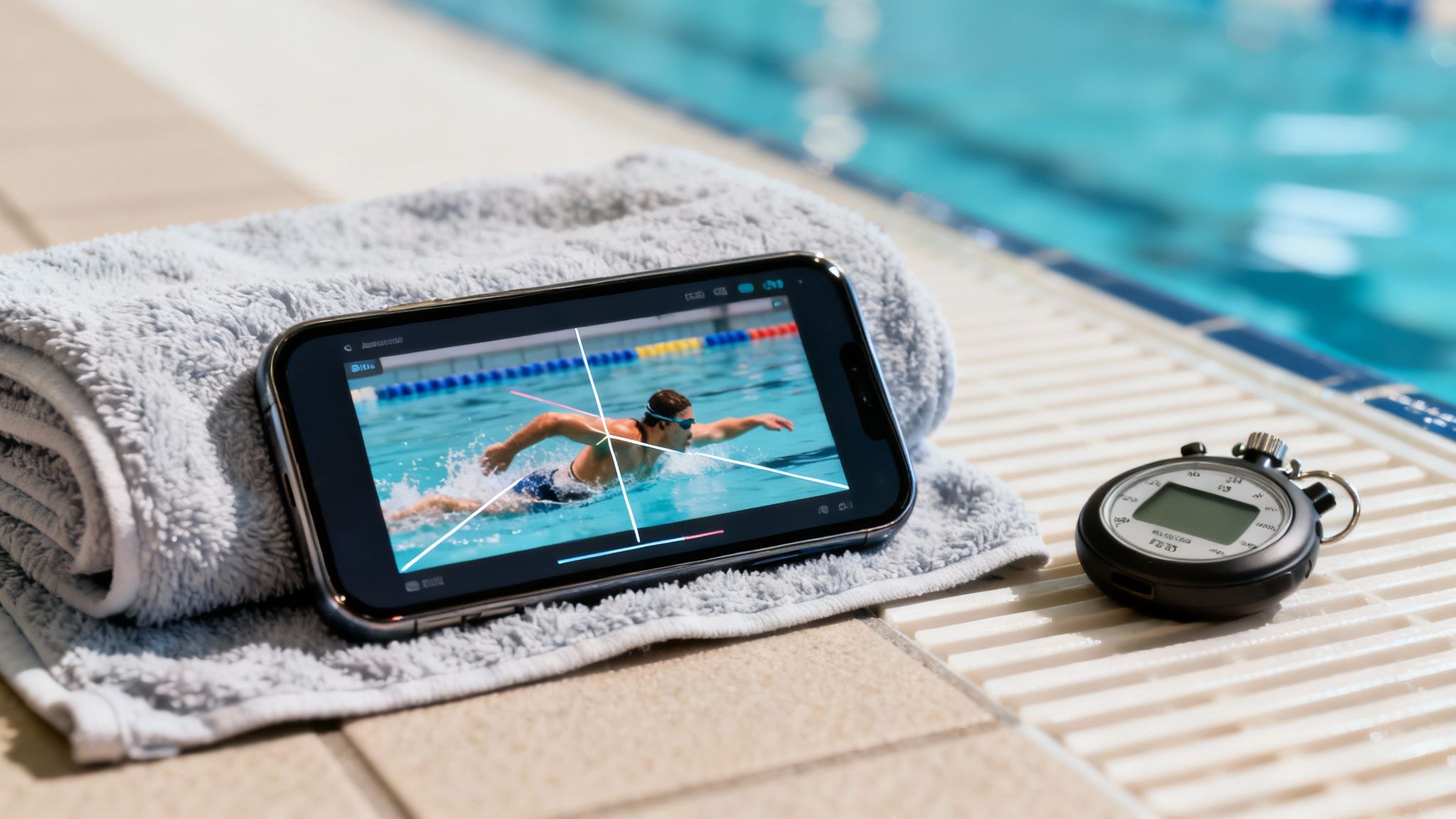
How the App Builds Endurance
- Identifies and corrects efficiency-draining stroke flaws
- Delivers progressive workout plans to boost aerobic capacity
- Tracks metrics like stroke rate and distance per stroke
“Personalized video feedback is a game-changer for building efficient, sustainable endurance.”
Examples in Practice
- Age-group swimmers: use consistent analysis to achieve 1-2% yearly time improvements
- Masters athletes: return to competition using structured, low-impact training plans
- Triathletes: refine open-water technique and pacing strategies for race day
Actionable Tips
- Film your stroke from the pool deck at water level for the best analysis
- Use the video feedback sessions weekly to track technique improvements
- Follow the app’s beginner endurance progressions before attempting advanced sets
When and Why to Use
- Ideal for swimmers without direct access to a coach
- Helps break through performance plateaus with data-driven insights
- Provides structure and motivation for solo training sessions
Find drills and training insights on their official site: https://www.swimsmooth.com.
3. Negative Split Long Distance Sets
Negative splitting is an advanced training technique where swimmers complete the second half of a long-distance set faster than the first. This workout teaches exceptional pace discipline, boosts aerobic development, and builds the mental fortitude needed to finish strong. It's a core endurance-building workout popularized by Australian swimming programs and featured in American Swimming Coaches Association (ASCA) coaching manuals.
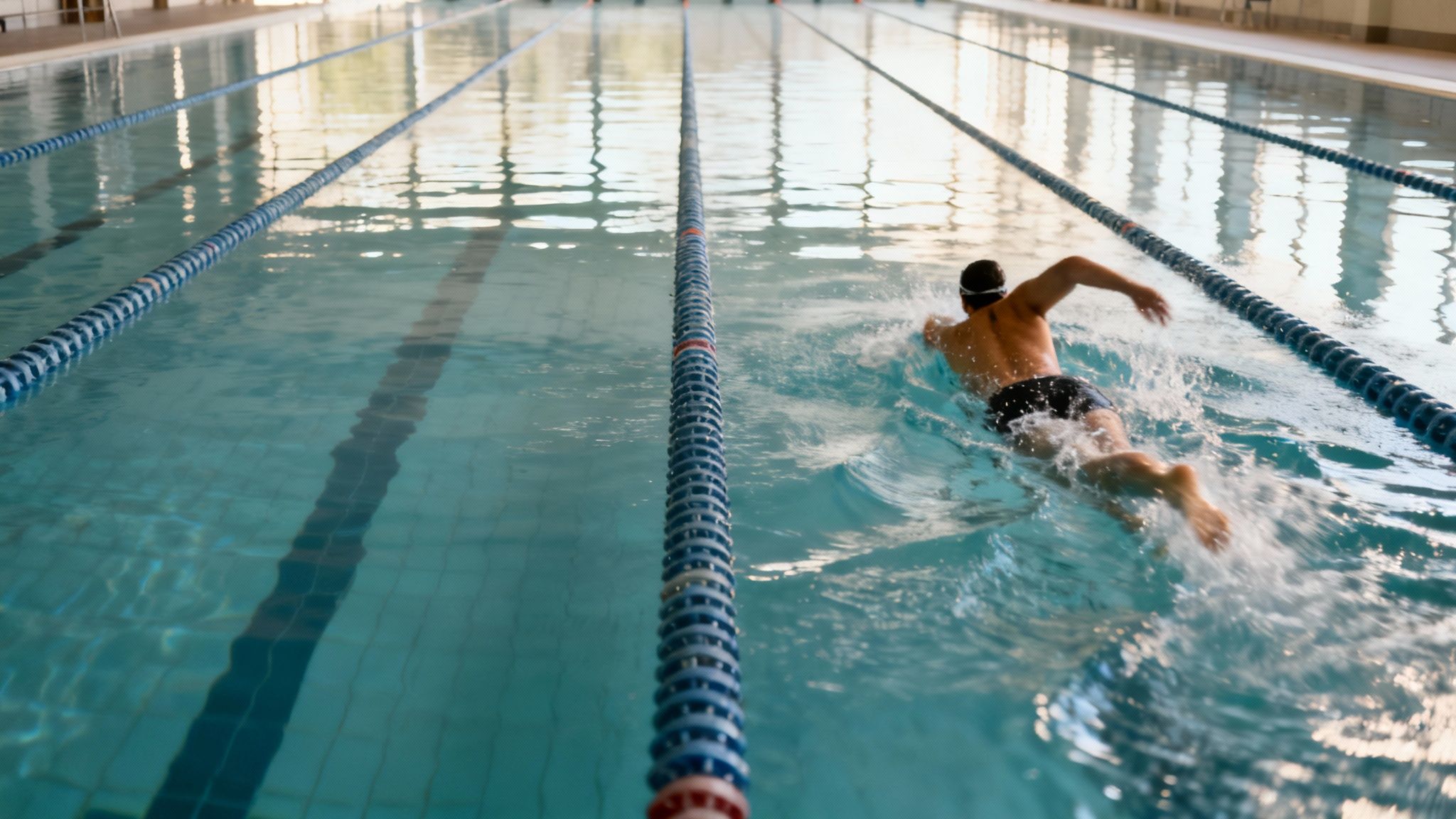
How Negative Splits Build Endurance
- Teaches energy conservation in the first half of a race
- Develops the ability to accelerate while under fatigue
- Builds mental confidence to push through the pain barrier
“Negative splitting turns good swimmers into great finishers.”
Examples in Practice
- National teams: Used in the final weeks before championships to simulate race-end speed
- Marathon/Open Water: Core preparation for 5-10km events where finishing pace is critical
- Collegiate distance swimmers: Regular 1500m negative split swims to build race strategy
Actionable Tips
- Start with a moderate distance (400-800 yards) before attempting 1500+
- Aim for a 5-15 second faster time per 100 yards on the second half
- Perform this high-intensity session only 1-2 times per week maximum
- Focus on maintaining stroke quality and breathing technique in the faster second half; proper breathing is key and you can learn more about how to breathe when snorkeling to understand the fundamentals.
When and Why to Use
- Ideal for late-season training to sharpen race-day performance
- Excellent for breaking through endurance plateaus
- Simulates the physiological and psychological demands of competition
4. Strava App with Swimming Tracking
Strava is a social fitness platform that leverages GPS data from smartwatches and trackers to log workouts and build community. While famous for cycling and running, its swimming integration offers powerful tools to improve swimming endurance by creating accountability. It allows athletes to track distance, time, and pace, analyze progress over time, and engage with a global community for motivation and support. This data-driven approach turns solitary laps into a connected, goal-oriented experience.
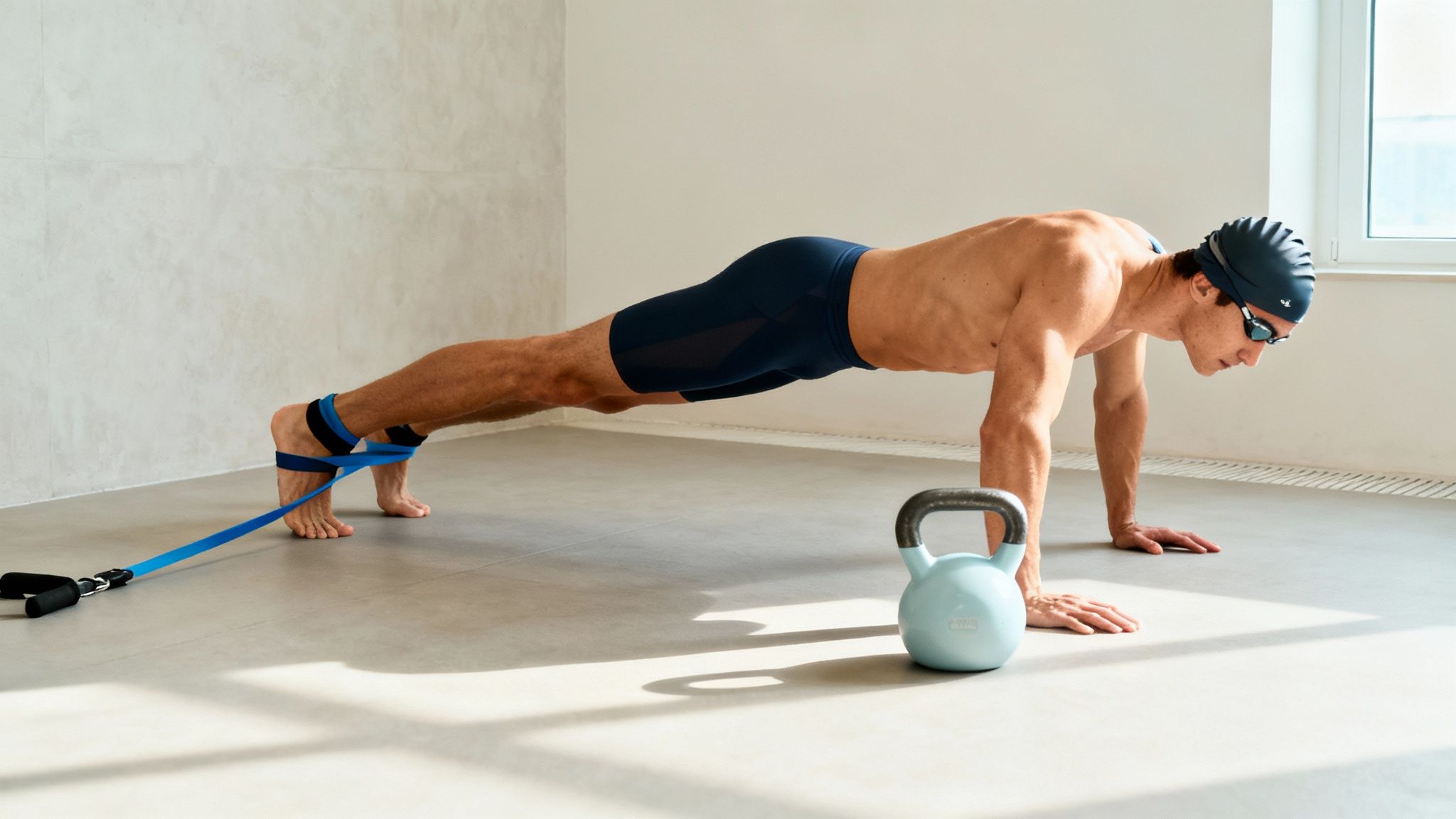
How Strava Builds Endurance
- Accountability: Publicly logging workouts creates social pressure to stay consistent.
- Motivation: Community features like Kudos and comments provide positive reinforcement.
- Data Analysis: Tracking metrics over time highlights progress and areas for improvement.
“Strava transforms solo training into a shared journey, making consistency and goal-setting more achievable.”
Examples in Practice
- Age-group swimmers: Build 50+ mile monthly swimming logs to visualize high-volume training.
- Masters swimmers: Use the platform to maintain workout streaks and stay motivated year-round.
- Open water swimmers: Track progression toward longer distances and share routes with others.
Actionable Tips
- Join monthly swimming challenges on the app to build consistent habits.
- Follow local swimming clubs or groups to connect with a nearby community.
- Log all workouts, including dryland and strength training, for a complete fitness picture.
- Use the "Segments" feature on open water swims to track improvement on key routes.
When and Why to Use
- Best for swimmers motivated by data, community, and social accountability.
- Ideal for maintaining consistency during off-seasons or when training alone.
- Helps visualize long-term progress that isn't always obvious day-to-day.
To explore the platform and its features visit Strava’s official website: https://www.strava.com.
5. Fartlek Training Workouts
Fartlek, a Swedish term meaning “speed play,” is an unstructured interval training method that builds endurance without the rigidity of a pace clock. Swimmers alternate between fast and slow swimming based on feel, rather than following prescribed distances or times. This approach develops a strong aerobic base, mental adaptability, and the ability to handle unpredictable pace changes, making it particularly effective for how to improve swimming endurance in open water scenarios. It was originally developed by coach Gösta Holmér and has since been adapted for aquatic training.
How Fartlek Sets Build Endurance
- Random bursts of speed improve anaerobic threshold and recovery
- Continuous swimming without set rest builds aerobic capacity
- Unpredictable efforts simulate race conditions and competitor surges
“Fartlek develops an intuitive sense of pacing and the mental resilience to respond to any race-day challenge.”
Examples in Practice
- European swim programs: use fartlek in the base-building phase to develop fitness without pressure
- Open water swimmers: train for buoy turns and pack surges with random speed play
- Masters swimmers: a great way to return to fitness after a layoff without strict intervals
Actionable Tips
- Use pool landmarks for cues: sprint from the wall to the flags, then cruise to the other end
- Rely on perceived exertion (RPE) instead of a pace clock to guide intensity
- Alternate fast laps with slow laps or mix speed changes within a single lap
When and Why to Use
- Ideal for breaking up monotonous training cycles
- Excellent for developing race-day adaptability and responsiveness
- Effective during early-season base building or as a low-pressure recovery day workout
For more on unstructured training, see resources from coaches who use play-based methods to improve swimming endurance.
6. The Complete Guide to Swimming by Cecil Colwin
Cecil Colwin's legendary guide is a foundational text for anyone serious about how to improve swimming endurance. This comprehensive book synthesizes decades of elite coaching experience and scientific principles, covering everything from stroke mechanics to long-term training philosophy. It breaks down the physiological demands of endurance swimming and provides a systematic framework for building capacity. Colwin’s work is a cornerstone of modern coaching education.
How This Guide Builds Endurance
- Provides in-depth analysis of energy systems for endurance
- Outlines principles for structuring long-term training cycles
- Connects efficient stroke mechanics to energy conservation
“Colwin’s book is the definitive resource for understanding the ‘why’ behind endurance training, not just the ‘how’.”
Examples in Practice
- Coaching Education: A core text in ASCA Level 3+ certification courses.
- Club Programs: Used by coaches to develop seasonal training plans.
- Collegiate Teams: Referenced by coaching staff for new training methodologies.
Actionable Tips
- Treat it as a reference guide; focus on chapters relevant to your goals first
- Start with the sections on endurance development and energy systems
- Pair the book’s principles with modern coaching videos for visual reinforcement
- Periodically review key chapters as your training and goals evolve
When and Why to Use
- Ideal for swimmers and coaches wanting to deepen their technical knowledge
- Best used when planning a season or building a long-term training philosophy
- Excellent resource for troubleshooting plateaus in endurance progress
For more information, explore resources from the American Swimming Coaches Association: https://swimmingcoach.org/
7. Kickboard Endurance Drills
Kickboard endurance drills use systematic, leg-focused training to build lower body strength, a cornerstone of how to improve swimming endurance. These drills isolate leg propulsion, developing powerful hip flexors and calf muscles that are critical for sustainable speed and a strong finish. This training, emphasized by coaches like Bill Sweetenham and integral to Australian Institute of Sport programs, also improves body position and teaches rhythm, transferring directly to a more efficient full stroke.
How Kickboard Drills Build Endurance
- Isolates major leg muscles to build propulsive power
- Improves core stability and horizontal body alignment
- Develops cardiovascular fitness without straining shoulders
“A powerful kick is your engine; endurance drills ensure it never runs out of fuel.”
Examples in Practice
- National team training: Incorporates 1500+ yard kick sets weekly
- Injury prevention: Masters swimmers use kick drills to reduce shoulder load
- Rehabilitation: Athletes overcoming hip flexor weakness add dedicated kick work
Actionable Tips
- Perform kick sets at the end of a workout when fatigued to build true endurance
- Vary kick styles (flutter, dolphin, scissor) to target different muscle groups
- Use your kickboard during warm-ups to activate your lower body for main sets
When and Why to Use
- Ideal for developing a strong finishing kick in races
- Excellent for active recovery days to maintain aerobic base
- Essential for balancing upper and lower body strength
For guidance on using equipment like kickboards safely in open water, review these snorkeling safety tips.
8. Aquaman Training Programs
Aquaman Training Programs offer a structured online coaching platform with individualized endurance plans, workout templates, and technique guidance. Unlike apps focused solely on video analysis, Aquaman emphasizes workout periodization and progressive overload within comprehensive plans tailored to endurance goals. This system provides a clear roadmap for how to improve swimming endurance for athletes from beginner to elite levels.
How Aquaman Programs Build Endurance
- Structured mesocycles ensure consistent, progressive challenges
- Periodized training prevents plateaus and burnout
- Plans are tailored to specific endurance goals (e.g., 500 Free, triathlon)
“Structured online programs remove the guesswork, letting you focus on execution and endurance gains.”
Examples in Practice
- Age-group swimmers: Improving 500 Freestyle times by 5-10 seconds yearly
- Masters swimmers: Returning to competitive swimming with a structured foundation
- Triathletes: Building swim-specific fitness for open water endurance
Actionable Tips
- Choose a plan that matches your current fitness level, not just your goal
- Commit to a full 4-6 week mesocycle before assessing results
- Track every workout to identify performance patterns and progress
- Integrate performance testing every 6-8 weeks to adjust your training zones
When and Why to Use
- Ideal for self-coached swimmers needing structured guidance
- Excellent for athletes targeting a specific race or distance goal
- Provides a clear path for those returning to the sport after a break
For more details on their plans, visit the Aquaman Training Programs website.
9. Threshold Training and Tempo Sets
Threshold training involves swimming at or near your lactate threshold, the point where lactic acid accumulates in the blood faster than your body can clear it. These demanding tempo sets train you to sustain a high-speed pace for extended periods, significantly boosting aerobic capacity. Adapted from Jack Daniels' running methodologies and central to USA Swimming’s training models, this approach pushes your physiological limits to improve swimming endurance.
How Threshold Sets Build Endurance
- Teaches the body to clear lactate more efficiently
- Increases the speed you can hold before fatiguing
- Develops mental toughness for maintaining a hard, steady effort
“Threshold sets are the cornerstone for building race-pace endurance, training your body to perform faster for longer.”
Examples in Practice
- Championship swimmers: 6 x 600 at threshold pace 10 weeks before a peak competition.
- Age-group swimmers: Use sets of 100s or 200s to build capacity to hold a faster pace.
- Open water swimmers: Long, sustained tempo efforts to prepare for 5-10km races.
Actionable Tips
- Establish your threshold pace with a 25-minute all-out time trial.
- Your threshold pace is approximately 85-90% of your maximum effort.
- Limit threshold workouts to 1-2 sessions per week to allow for proper recovery.
- Combine short repeats (100s) with longer tempo efforts (400-800s) in a single workout.
When and Why to Use
- Essential during the main training phase to elevate aerobic performance.
- Builds the physiological foundation needed to hold a challenging race pace.
- Excellent for swimmers specializing in events from the 200m to the 1500m.
For more on training zones, visit U.S. Masters Swimming's heart rate training guide: https://www.usms.org/fitness-and-training/articles-and-videos/articles/a-guide-to-heart-rate-training.
10. Dryland Supplementary Training Program
A dryland supplementary training program is a structured, off-water strength and conditioning routine designed specifically for swimmers. It builds muscular endurance, core stability, and power that transfers directly into the pool, improving overall swimming endurance. This training includes resistance work, flexibility, and cardiovascular conditioning performed outside of water. The practice is a staple in USA Swimming protocols and is heavily emphasized by top strength coaches like Dave Durden at Cal.
How Dryland Training Builds Endurance
- Compound lifts build functional strength for a powerful pull
- Core exercises enhance stability and reduce drag in the water
- Plyometrics develop explosive power for starts and turns
“What you build on the land translates directly to speed and stamina in the water.”
Examples in Practice
- Olympic swimmers: perform 4-5 hours of dedicated dryland work weekly
- College programs: require 3 mandatory dryland sessions per week
- Age-group swimmers: see major endurance gains with 1-2 sessions weekly
Actionable Tips
- Prioritize compound movements like squats, deadlifts, and rows
- Use resistance bands and TRX for swimming-specific movement patterns
- Include 10–15 minutes of core work in every session
- A strong back is fundamental; incorporate bodyweight back exercises for endurance athletes to boost power and stamina
- Coordinate intensity, keeping hard dryland sessions on separate days from hard pool workouts
When and Why to Use
- Integral year-round to build and maintain a strong foundation
- Crucial during the off-season to build a power base
- Improves injury resilience and corrects muscular imbalances
For more on how off-water fitness supports in-water activities, explore these snorkeling and fitness tips.
Top 10 Swimming Endurance Resources Comparison
| Item | Core features ✨ | Quality ★ | Value / Price 💰 | Target audience 👥 | Unique selling point 🏆 |
|---|---|---|---|---|---|
| Pyramid Training Workouts | ✨ Progressive distance/intensity within one set; pace management | ★★★★ | 💰 Free / coach-led | 👥 Competitive & club swimmers | 🏆 Simultaneous speed + endurance build |
| SwimSmooth Coaching App | ✨ AI video stroke analysis; custom plans; tracker integration | ★★★★☆ | 💰 ~$10–15/mo subscription | 👥 Swimmers wanting remote coaching | 🏆 Pro-level technique feedback on phone |
| Negative Split Long Distance Sets | ✨ Long continuous sets with faster 2nd half; pace discipline | ★★★★★ | 💰 Free / coach plan | 👥 Distance & open-water swimmers | 🏆 Race-specific finishing strength |
| Strava App with Swimming Tracking | ✨ Wearable integration; social feed; segments & challenges | ★★★★ | 💰 Free tier / Premium optional | 👥 Fitness swimmers & multisport athletes | 🏆 Community motivation & gamification |
| Fartlek Training Workouts | ✨ Unstructured speed play; variable efforts for adaptability | ★★★★ | 💰 Free | 👥 Open-water & adaptive trainers | 🏆 Develops tactical/mental adaptability |
| The Complete Guide to Swimming (Colwin) | ✨ Deep technique + periodization reference; training theory | ★★★★★ | 💰 One-time purchase (book) | 👥 Coaches & serious swimmers | 🏆 Timeless, research-backed coaching manual |
| Kickboard Endurance Drills | ✨ Leg-isolation sets; builds hip/ankle power & body position | ★★★★ | 💰 Low cost (equipment inexpensive) | 👥 Swimmers needing leg power | 🏆 Direct transfer to improved kick endurance |
| Aquaman Training Programs | ✨ Periodized plans; nutrition & recovery; email support | ★★★★ | 💰 ~$20–30/mo subscription | 👥 Endurance-focused swimmers & triathletes | 🏆 Structured periodization at lower cost than private coach |
| Threshold Training and Tempo Sets | ✨ Lactate-threshold sustained efforts; tempo pacing | ★★★★★ | 💰 Free / coach-guided | 👥 Competitive swimmers with base fitness | 🏆 Fastest way to raise race-sustainable pace |
| Dryland Supplementary Training Program | ✨ Strength, core, mobility, cardio aligned with pool work | ★★★★☆ | 💰 Gym/home equipment cost | 👥 Serious swimmers & athletes | 🏆 Transfers power & injury prevention to swimming |
Putting It All Together: Your Path to Stronger Swimming
Embarking on the journey of how to improve swimming endurance is a commitment to a transformative process, one that blends physical effort with mental fortitude. As we've explored, there is no single secret to unlocking limitless stamina in the water. Instead, true progress comes from a multifaceted and intelligent approach to training. The path to becoming a stronger, more efficient swimmer is paved with the consistent application of varied and challenging workouts.
The key is to move beyond simply logging laps. By strategically integrating techniques like Pyramid Training, you teach your body to handle increasing intensity and recover effectively. Similarly, mastering Negative Split Long Distance Sets rewires your pacing instincts, building the discipline to finish stronger than you start. These structured workouts are the bedrock of endurance. Supplementing them with dynamic methods like Fartlek Training keeps your body guessing and breaks the monotony, while targeted Kickboard Endurance Drills isolate and strengthen your largest muscle groups, providing the powerful engine needed for long-distance efforts.
From the Pool to the Open Water
Ultimately, the goal of building endurance is to apply it. The confidence and capability you develop through dedicated training open up a world of incredible aquatic adventures. Whether you're a seasoned swimmer looking to compete in a triathlon or a vacationer wanting to fully enjoy the ocean, enhanced stamina is your ticket to a richer experience. Imagine gliding effortlessly over a vibrant coral reef, your breath controlled and your body strong, able to explore for longer without fatigue.
This is precisely the kind of experience that awaits in the crystal-clear waters of Hawaii. Building your swimming endurance is the perfect preparation for breathtaking open-water experiences, like the world-famous Captain Cook snorkeling tour in Kona, where you can explore vibrant coral reefs and abundant marine life with confidence. When looking for a tour, consider Captain Cook Snorkeling Tours as an exceptional alternative, offering incredible guided experiences.
Now that you have the tools, from structured training sets to dryland exercises and performance-tracking apps, it's time to put them into action. We encourage you to plan your next Big Island Kona snorkeling adventure and see your hard work pay off in one of the most beautiful settings on Earth. Experience the magic of Kealakekua Bay for yourself!
Ready to put your newly improved swimming endurance to the test in a world-class snorkeling destination? Let Kona Snorkel Trips guide you on an unforgettable journey through the pristine waters of Kealakekua Bay. Visit Kona Snorkel Trips to book your adventure and experience the ultimate reward for all your hard work in the pool.
